|
1.
CENTRAL/ WEST AFRICA
Exporters show slight optimism about current quarter
There were a few minor price changes through the end of
May. Log business with Asian countries had held very
firm through the month with possibly more activity than
producers and exporters had expected and some reports of
difficulty in filling buyers¡¯ orders for volume of species
such as padouk and belli. As a consequence, prices have
moved higher. Okoume also was in good demand.
Although some exporters had expected a weaker price
trend, demand was good enough to see a very slight price
gain for okoume logs at the month¡¯s end.
By contrast, most lumber prices were again unchanged
except for one or two species experiencing declines
because of low or no demand. As previously reported,
Europe was still very quiet, with very little demand as
importers continued to de-stock. This occurred even
though traders were becoming aware that replacement
costs were likely to be higher than consumer prices, which
they are having to accept in selling existing stock in
domestic markets.
Asian demand for sawn lumber appears to be less buoyant
than in recent months. While reported prices have changed
very little and appear stable, this was because of poor
demand rather than any substantial business by volume.
While importing countries can still find countries that
permit log exports, there will be always a tendency for the
importing countries to support local sawmilling industries.
During times of more difficult trading conditions, as in the
current crisis, there is an equal tendency for producer
countries to allow logs to be exported and temporarily
postpone plans for curtailments that might affect revenues.
Overall, the West African market appeared to be balanced
and stable. Exporters were if anything slightly more
optimistic for continued stability through the current
quarter.
ITTO and RRI conference in Yaound¨¦ draws attention to critical problem of forest tenure
Mr. Emmanuel Ze Meka, ITTO Executive Director,
indicated at a conference on forest tenure in Yaound¨¦ that
the ¡®slowness of reform¡¯ efforts on land tenure are a key
obstacle to reducing poverty and improving livelihoods.
According to a press release from the ITTO, a draft report
launched at the event, which was hosted by Cameroon and
organized by the ITTO and Rights and Resources
International (RRI), discussed the significant problem of
deforestation and slow tenure reform efforts in Africa. The
report also explained how progress on land tenure could
help slow deforestation and climate change and reduce
poverty.
The report showcased at the meeting indicated that
African nations had less control over land rights than did
other tropical nations. Although it noted that countries
such as Angola, Cameroon, and the Democratic Republic
of Congo had land tenure arrangements for community
land, the process needed to be scaled up. It suggested that
tenure arrangements could also assist countries in
benefiting from environmental services activities such as
carbon payments. The report will be finalized based on
input from conference participants.
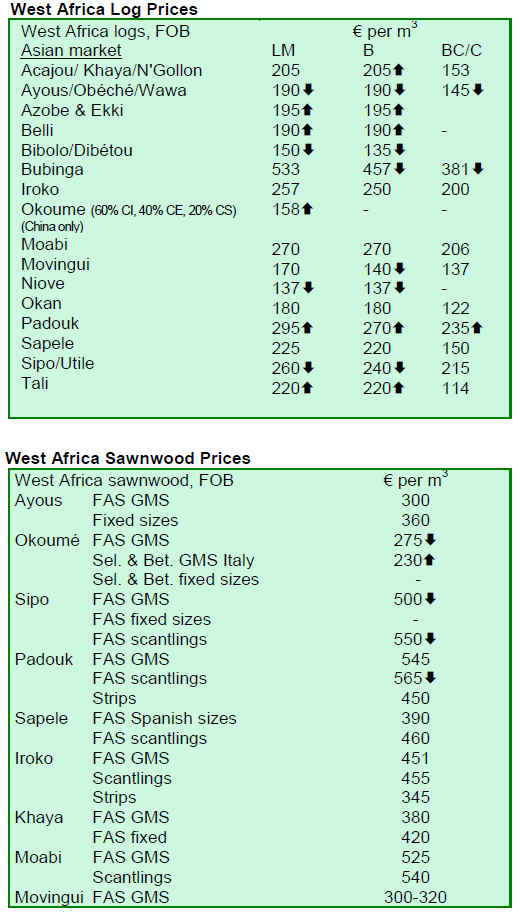
2. GHANA
Ghana¡¯s first quarter trade slows to major markets
Ghana¡¯s first quarter wood products exports for 2009 were
worth about EUR30 million from a cumulative volume of
93,424 m³. By comparison, figures from the same period
in 2008 showed a contraction of 34.7% and 31.4% by
volume and value, respectively, due to low demand for
these products by the major markets of Germany, Italy,
Spain, the UK and the US.
During the first quarter of 2009, tertiary product exports
registered EUR1.90 million compared with EUR3.28
million over January to March 2008. Secondary products
generated a total of EUR21.95 million from January to
March 2009 against EUR37.60 million over January to
March 2008. Europe imported EUR12.17 million
(40.46%) by value and 29,815 m³ (31.91%) by volume.
However, a 44.7% rise by volume and a corresponding
3.6% increase by value was recorded for air dried (AD)
lumber, while all other wood products registered
reductions in both volume and value for the first quarter of
2009 against 2008. No exports were recorded for furniture
parts and profile boards within the period.

A larger percentage of Ghana¡¯s exports went to African
countries, particularly those within ECOWAS (mainly
Senegal, Nigeria, Niger, Gambia, Mali, Benin, Burkina
Faso and Togo), even though Ghana¡¯s overall exports to
the African region fell in 2009 compared to 2008. Ghana¡¯s
wood products exports increased by volume to 39.95% in
2009 from the previous 32.45% recorded in 2008 for the
same period. Plywood and air-dried lumber of ceiba and
chenchen were of particular interest to Nigeria and Niger.
Ghana also earned 38.20% of its export revenue from
African markets in the first quarter of 2009 compared to
28.69% in 2008.
The emerging markets in Asia and the Far East: India,
Malaysia, Taiwan, China, Singapore and Thailand together
contributed EUR3 million (10%) to the total wood export
value from January to March 2009. India continues to be
the leading importer of teak poles, billet and teak lumber
(AD).
The US accounted for 6.6% and 2.2% of Ghana¡¯s total
exports of wood products by value and volume,
respectively, from January to March 2009 compared to
12.3% and 9.0% in January to March 2008. The US
market has maintained its position as the most lucrative
destination for Ghana¡¯s lumber (KD) and rotary veneer
exports.
By value, the ECOWAS countries absorbed EUR10.28
million (89.45%) of Africa¡¯s EUR11.50 million wood
imports from Ghana from January to March 2009. Similar
to exports by value, plywood and air dried lumber
(chenchen and ceiba) continued to interest the Nigeria and
Niger markets.
The Middle Eastern countries, notably Saudi Arabia,
Lebanon, United Arab Emirates and Israel together
contributed EUR1.21 million (4.02%) to the total export
value from January to March 2009.

3.
MALAYSIA
MFPC Chair calls for new marketing strategies
As reported in the Business Times, Chairman of the
Malaysian Furniture Promotional Council (MFPC) Mr.
Merlyn Kasimir encouraged Malaysian furniture
manufacturers to enhance new marketing strategies to
reposition themselves globally while achieving higher
productivity and maintaining lower production costs.
In 2008, exports of Malaysian furniture grew by 2% and
were worth RM8.72 billion, while imports of furniture
grew 9.8% and valued at RM1.5 billion. However, trade in
Malaysian furniture exports declined by 14.2% in January
2009 and 13.8% in February 2009. On an annual basis,
Malaysian furniture exports were worth about 2.5% of the
world furniture trade.
Malaysian construction sector suffers continuing slump
Demand for construction materials in Malaysia continued
to decline, pushing down prices for construction materials.
Steel, a competitor with timber products, was expected to
further drop 25% in price in 2009. The trends, reported by
the Malaysian Iron & Steel Industry Federation in The
Star, showed declines in production of 10.7% to 7.8
million tons in 2008. Domestic prices of steel bars had
tumbled from RM3,800 per ton in July 2008 to RM2,000
in recent weeks.
Sarawak scales back timber quota rate
According to Bernama News, Sarawak scaled back the
enforcement of its rules on the timber quota rate for the
first six months of 2009 to help timber exporters weather
the global recession. The standard royalty rate for timber
has already been reduced from RM65 to RM50 per meter
from January to December 2009. The payment period for
timber royalties has also been extended from two weeks to
three months.
Exports of timber products from Sarawak declined about
30% to RM1.3 billion in the first quarter of 2009,
compared to RM1.9 billion in the first quarter of 2008.
The volume of timber products also dropped 34% during
the same period. Royalties from timber products plunged
by about 39% to RM82.6 million in the first quarter of
2009, compared to RM134.9 million in the first quarter of
2008.
In 2008, the Sarawak timber industry registered a 2.6%
rise in export revenues worth RM7.9 billion compared to
RM7.7 billion in 2007.
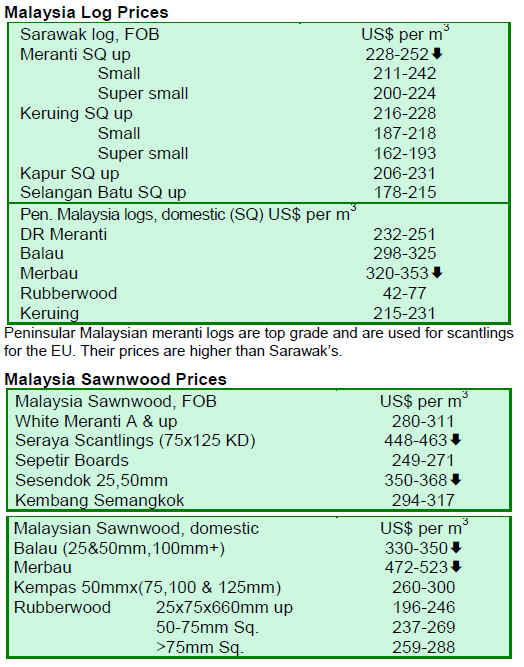
4.
INDONESIA
Indonesian panel manufacturers hit by slump in demand
According to Bloomberg News, the Japanese economy
declined sharply in January to March 2009, with GDP
falling an annualized 15.2%. Meanwhile, Channel News
Asia reported US housing starts and building permits
dropped by 3.3% from March to April 2009 to an annual
rate of 494,000 units. The statistics, announced by the US
Commerce Department, showed the lowest results since
the data began to be collected in 1959. The weak demand
for products in both the US and Japan continue to hit
Indonesian plywood and panel-products manufacturers
hard.
However, as local spending expands rapidly and with GDP
standing at 4.4% for the first quarter of 2009, Indonesian
timber product manufacturers were beginning to look to
the local market to help mitigate the recession, as
consumer confidence reached a four-year high in April
2009. Bloomberg News reported that consumer spending
increased sharply by 5.8% in the first quarter of 2009,
from 4.8% in fourth quarter of 2008.
APHI warns too many levies hurt Indonesian competitiveness
The Association of Indonesian Forest Concessionaires
(APHI) has indicated total levies on forest-based
industries, including those imposed by local governments,
account for more than 30% of the production cost of local
forestry companies. APHI officials said the levies are not
only a burden to forestry companies but also render
Indonesian timber products less competitive in comparison
to Malaysia and China¡¯s timber products. According to
The Jakarta Post, total levies imposed on timber products
in neighboring countries in Southeast Asia stand at 15% or
less.
In addition, the levies could amount to as much as USD30
per m³ for every USD100 per m³ of timber product sold.
There are a total of 28 types of levies imposed on
Indonesian timber products, ranging from property taxes
to forestry commissions. Moreover, the federal
government mandates that timber product manufacturers
must source their raw materials from production forests
instead of natural forests. As a result, manufacturers have
lost access to an important raw material supply. Current
output from production forests are on a decline.
Statistics compiled by the Central Statistics Agency
(BPS), indicated that Indonesia¡¯s exports of plywood have
declined from a high of USD3.4 billion in 1997 to USD1.5
billion in 2008. Both sawnwood and other timber product
exports have also dropped by value from 1997 to 2008. A
forecast by the Association of Indonesian Wood Panel
Producers (Apkindo) indicated that the plywood industry
could contract by another 40% in 2009.

5.
MYANMAR
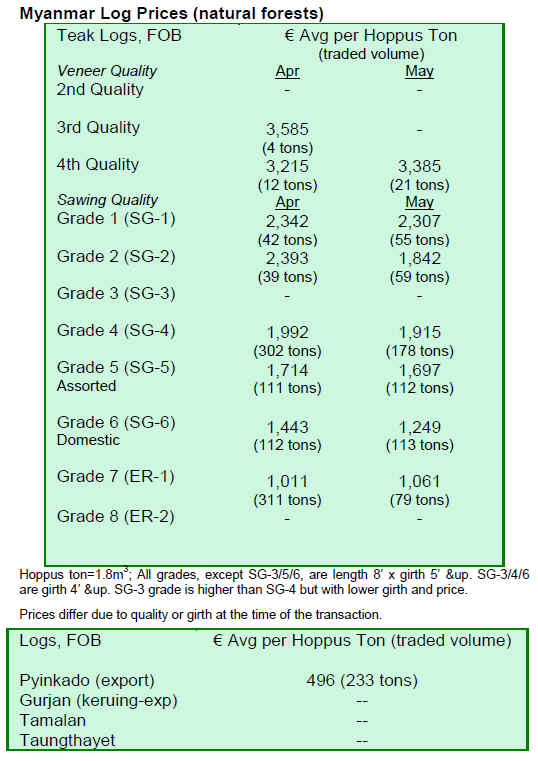
6. BRAZIL
New opportunities for teak wood in Mato Grosso
According to Painel Florestal, consumers and producers
will have the opportunity to learn more about the use and
application of teak. Young teak is not commonly used in
Brazil by industries which, due to lack of knowledge about
its benefits, prioritize the production of mature teak wood
for furniture and other decorative items. To reverse the
situation, the Mato Grosso Forest Plantation Association
(Arefloresta) will hold the 10th Mato Grosso Reforestation
Meeting in early June to focus on the potential uses of
young teak. The event will discuss, among other issues,
the physical, environmental, silvicultural properties and
marketing of teak in Brazil and worldwide.
The state of Mato Grosso is the largest producer of teak in
Brazil, accounting for 90% of the supply, with world
demand currently exceeding the product¡¯s availability.
According to Arefloresta, this will be another topic of
discussion at the event. Many see the use of young teak as
a way to open the market for increasing product
consumption and consumer interest.
Currently, young teak in Brazil is used as firewood by
energy-producing companies, grain- and meat-processing
mills, and the ceramic industry, among others. The teak
plantation in Mato Grosso covers an area around 60,000
ha, with a potential sustainable production of 900,000 m³
per year, although with little utilization of young teak
wood. The objective is to expand this market, to maximize
the potential of young teak and encourage higher domestic
consumption, as currently the largest demand for young
teak still comes from other countries.
Export value plunges in April 2009
Brazil¡¯s wood products exports (except pulp and paper)
dropped 45.8% by value compared to the same period in
2008. The charts below show the volume and value of
Brazil¡¯s exports for April 2009 compared to the same
month a year earlier:

Mato Grosso timber exports plummet by volume
Timber products, which rank fifth in terms of exports from
Mato Grosso, decreased 45.5% by volume in the first
quarter of this year compared with the same period of
2008. According to Expresso MT, sales fell from USD55
million in 2008 (representing 4.3% of total exports
statewide) to USD25 million in 2009 (1.4% in 2009).
These data show the timber industry has already felt the
effects of the global financial slowdown. The
entrepreneurs of the sector have been negotiating with the
government to lower the official reference timber price,
the minimum price established for timber exports. They
contend that official reference prices are set too high,
thereby affecting competitiveness of the forest-based
sector.
Timber processing is considered a solid business.
However, if there are no buyers, the current crisis in the
sector is expected to get worse. A steep drop in sales
occurred in both the domestic and foreign markets. The
sector has stocked timber to sell, but the consumer is not
willing to pay a premium to cover the high production
costs of the product.
Timber industry seeks ways to reverse losses
Entrepreneurs of the timber sector and business leaders of
Paran¨¢ trade unions discussed solutions to address the
crisis in the timber sector and its business development
during a sectoral forum on the timber industry. The forum
was organized by the Federation of Industries of Paran¨¢
(FIEP) in Curitiba. Participants at the forum suggested
strategies to reverse declining sales in the sector such as
establishing a financing programme for residential
construction made from timber and investing in innovation
and technology.
At the forum, the Brazilian Association of Mechanically-
Processed Timber Industry (ABIMCI) presented data on
the situation of the timber industry in the Southern state of
Paran¨¢. Brazilian exports of solidwood products have been
decreasing since 2007, but the global financial crisis has
made the situation much worse. There was a 45% drop in
the volume of timber product exports in Paran¨¢ in the first
quarter of 2009 compared to the same period of 2008. The
problem worsened as the timber market in Paran¨¢ has
practically disappeared.
ABIMCI suggested a solution to foster and expand the
domestic market, by creating a programme for financing
timber-based construction. Other measures to address the
crisis included reducing high taxes, establishing proper
public policies in each state, and classifying the forestbased
industry in the category of agribusiness to enable it
to qualify for greater benefits.
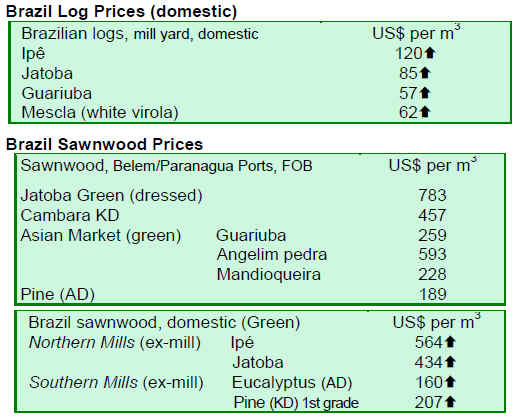
7.
PERU
Government to distribute forest grants
The Ministry of Agriculture indicated that regional
governments would distribute new forest grants beginning
from 2010 to promote private investment in the forest
sector and help prevent illegal trade. The Director of the
Department of Forestry and Wildlife said there was
potential to consider nearly eight million hectares of
forests for the grants. He indicated the Ministry of
Agriculture would also transfer many forest-related duties
to the regions by 31 December 2009.
Peru clinches funding for forest conservation
Peru¡¯s Department of Environment has received EUR7
million from Germany to conserve forests and about
USD40 million from Japan to preserve forests that are
important to climate change mitigate. This will enable the
Peruvian government to set aside nearly USD50 million to
conserve forests in the Amazon and guarantee proper use
of wood resources, noted Minister of the Environment
Antonio Brack. The Minister also discussed the ongoing
process to address environmental services through
improved management of forest grants. He noted that
ecotourism was an important aspect of the conservation of
forests and should be considered an important
environmental service in Peru.
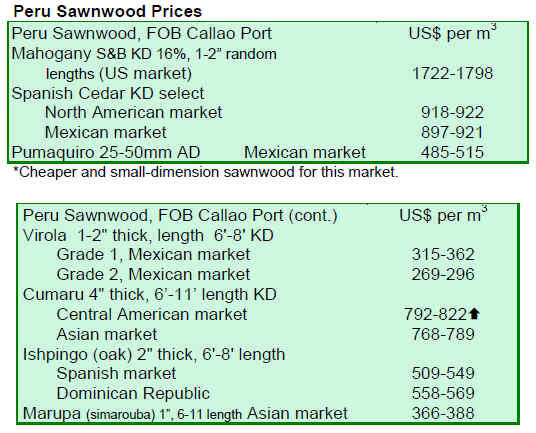
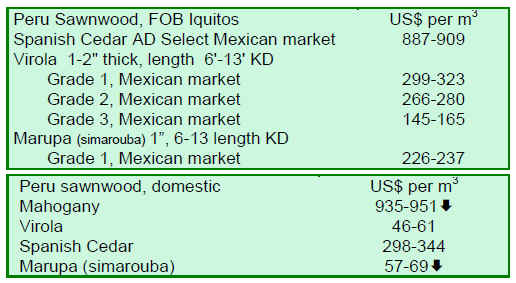
8. BOLIVIA
Bolivia reorganizes forestry agency
Under the new Bolivian Constitution, the
Superintendencia Forestal (SF), which was responsible for
the regulation and supervision of forestry matters in
Bolivia, will become subordinate to the Ministry of Rural
Development and Land. The new entity, ¡®the Authority for
Social Control of Forests and Land (ABT)¡¯, will regulate
activities associated with forests and agriculture and
ensure natural resources are used in a sustainable way. As
such, the functions of the ABT do not change much from
the old functions of the SF. It is not yet known whether the
headquarters for this new entity will be in Santa Cruz or in
the capital of La Paz. The rationale for the change,
according to some officials, is to generate additional
government savings and reduce bureaucracy.

9. Mexico
PROCYMAF programme to invest over 128 million
pesos
The National Forest Agency (CONAFOR) will allocate
over 128 million pesos to projects under the 2009
Communitarian Forest Development Programme
(PROCYMAF). The programme has recently approved
around 1,380 technical proposals for financing, which are
designed to benefit 792 agrarian centers in 12 states of the
country. The National Forest Agency will promote actions
to conserve and sustainably manage national resources of
common lands and indigenous forest communities by
identifying and consolidating the process of local
development.
A total of 2,384 technical proposals were received from
1,117 agrarian centers or associations of common lands
and communities in the states of Oaxaca, Gurerrero,
Michoacan, Jalisco, Durango, Chihuahua, Quintana Roo,
Chiapas, Campeche, the state of Mexico, Puebla and
Veracruz. The technical state committees of PROCYMAF
evaluated the proposals to see which were most
technically and socially viable. The states of Oaxaca,
Jalisco, Michoacan, the state of Mexico, and Durango
account for 56% of the proposals that will be supported
this year. Contracts and agreements with the beneficiaries
of the projects are in the process of being formulated.
10.
Guyana
Guyana¡¯s prices demonstrate stability over the
fortnight
Log prices for greenheart and purpleheart have remained
stable for the period of 1-15 May 2009 compared with 16¨C
31 April 2009. Prices for undressed sawnwood have also
remained fairly stable, while the prices for dressed
sawnwood (594/636) have marginally eased for the period
1-15 May 2009 as against 16-31 April 2009. Splitwood
prices for this period have been encouraging compared to
the last quarter prices.
Indoor furniture and craft items remained a stable
contributor to export value earnings compared to the
period 1-15 May 2009 as against the same period of 2008.
The Caribbean and European markets were the foremost
destinations for these value-added product categories.
The largest revenue earner from January to April 2009 was
sawnwood. Dressed sawnwood has dominated this product
category, representing 57% of total export revenue. Logs
have generated revenues accounting for approximately
10% of export revenue, down from 25% for the first four
months of last year. Value-added products, especially
doors, windows, spindles and other building components
remained stable, making an 8% contribution to export
earnings for both years. From all indications, export
revenues should increase in the third quarter and stabilize
in the last quarter of the year.
FPDMC hosts successful stakeholder forum
On 11 May 2009, the Forest Products Development and
Marketing Council (FPDMC) conducted a stakeholder
meeting to discuss the Council¡¯s strategic plan, which
includes working with stakeholders to improve the quality
and quantity of processed forest products both for the
domestic market and for export.
The meeting provided an opportunity for stakeholders to
share their views on a number of critical issues that impact
their business, the forestry sub-sector and the national
economy. The Council is also expected to monitor
marketing trends and engage stakeholders in this regard;
advise companies that need to diversify their product
range and markets; and intensify the promotion of the
Legal Verification System, which was started in 2007. The
newly formed FPDMC will also be at the forefront in
promulgating log export policy and training professionals
in relevant skills while continuing to support stakeholders¡¯
interests. It is expected that the FPDMC will assist the
forestry sector to be more competitive.
The Council¡¯s Chairperson noted the FPDMC had
deliberated on issues to take the industry forward. The
FPDMC will engage and work together with all
stakeholders, particularly to find ways to access markets
during the global economic slowdown. The Chairperson
added that the industry must be re-positioned to look
inwards for new market opportunities.
The FPDMC stakeholders¡¯ forum has broadened the
Council¡¯s mandate and guided the organization¡¯s strategic
and operational direction. It is now up to the Council to
organize itself and acquire the resources necessary to meet
relevant challenges and opportunities.
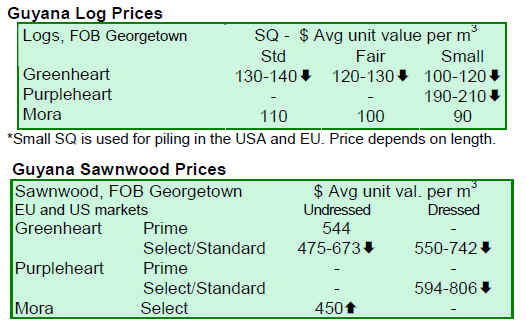
|